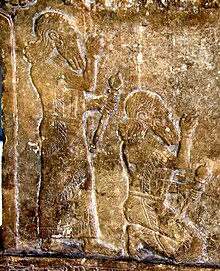Tukulti-Ninurta I (meaning: "my trust is in [the warrior god] Ninurta"; reigned c. 1243–1207 BC) was a king of Assyria during the Middle Assyrian Empire. He is known as the first king to use the title "King of Kings".
| Tukulti-Ninurta I | |
|---|---|
 Tukulti-Ninurta I depicted both standing and kneeling | |
| King of the Middle Assyrian Empire | |
| Reign | c. 1243–1207 BC[1] |
| Predecessor | Shalmaneser I |
| Successor | Ashur-nadin-apli |
| Issue | Ashur-nadin-apli, Enlil-kudurri-usur |
| Father | Shalmaneser I |
Biography
editTukulti-Ninurta I succeeded Shalmaneser I, his father, as king and won a major victory against the Hittite Empire at the Battle of Nihriya in the first half of his reign, appropriating Hittite territory in Asia Minor and the Levant. Tukulti-Ninurta I retained Assyrian control of Urartu, and later defeated Kashtiliash IV, the Kassite king of Babylonia, and captured the rival city of Babylon to ensure full Assyrian supremacy over Mesopotamia. He set himself up as king of Babylon, and took on the ancient title "King of Sumer and Akkad" first used by Ur-Nammu.
Tukulti-Ninurta had petitioned the god Shamash before beginning his counter offensive. Kashtiliash IV was captured, single-handed by Tukulti-Ninurta according to his account, who "trod with my feet upon his lordly neck as though it were a footstool" and deported him ignominiously in chains to Assyria. The victorious Assyrian demolished the walls of Babylon, massacred many of the inhabitants, pillaged and plundered his way across the city to the Esagila temple, where he made off with the statue of Marduk. After capturing Babylonia, he invaded the Arabian Peninsula, conquering the pre-Arab states of Dilmun and Meluhha.[2] Middle Assyrian texts recovered at ancient Dūr-Katlimmu include a letter from Tukulti-Ninurta to his sukkal rabi'u, or grand vizier, Ashur-iddin advising him of the approach of his general Shulman-mushabshu escorting the captive Kashtiliash, his wife, and his retinue which incorporated a large number of women, on his way to exile after his defeat. In the process he defeated the Elamites, who had themselves coveted Babylon. He also wrote an epic poem documenting his wars against Babylon and Elam. After a Babylonian revolt, he raided and plundered the temples in Babylon, regarded as an act of sacrilege to all Mesopotamians, including Assyrians. As relations with the priesthood in Ashur began deteriorating, Tukulti-Ninurta built a new capital city; Kar-Tukulti-Ninurta. However, his sons rebelled against him and besieged him in his new city. During the siege, he was murdered. One of them, Ashur-nadin-apli, would succeed him on the throne.
After his death, the Assyrian Empire fell into a brief period of stagnation. The Tukulti-Ninurta Epic describes the war between Tukulti-Ninurta I and Kashtiliash IV.[3]
-
Mace with the name of Tukulti-Ninurta I, Louvre Museum
-
Temple altar offered by Tukulti-Ninurta I. 1243-1207 BCE. From Assur, Iraq. Ancient Orient Museum, Istanbul
-
Foundation inscription of the temple of Ishtar at Assur built by Tukulti-Ninurta I. Lead. 1243-1207 BCE. From Iraq. Ancient Orient Museum, Istanbul
-
Campaigns of Tukulti-Ninurta I
Sources
edit- ^ Chen, Fei (2020). "Appendix I: A List of Assyrian Kings". Study on the Synchronistic King List from Ashur. Leiden: BRILL. ISBN 978-9004430914.
- ^ J. M. Munn-Rankin (1975). "Assyrian Military Power, 1300–1200 B.C.", in I. E. S. Edwards (ed.) Cambridge Ancient History, Volume 2, Part 2. Cambridge University Press. pp. 287–288, 298.
- ^ The Cambridge Ancient History, I. E. S. Edwards, C. J. Gadd, N. G. L. Hammond, (ed) I. E. S. Edwards, C. J. Gadd, N. G. L. Hammond, Edition 3, revised, Cambridge University Press, 1975, ISBN 0-521-08691-4, ISBN 978-0-521-08691-2, pg. 284-295
- ^ "stela British Museum". The British Museum.
External links
edit- Assyrian origins: discoveries at Ashur on the Tigris: antiquities in the Vorderasiatisches Museum, Berlin, an exhibition catalog from The Metropolitan Museum of Art Libraries (fully available online as PDF), which contains material on Tukulti-Ninurta I